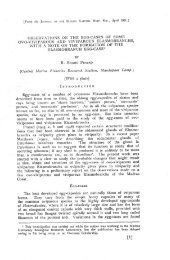PDF - Eprints@CMFRI
PDF - Eprints@CMFRI
PDF - Eprints@CMFRI
Create successful ePaper yourself
Turn your PDF publications into a flip-book with our unique Google optimized e-Paper software.
151<br />
Corallu m encrusting, thin, greater spread 5 cm, thickness at the broken edge 1 cm. At the underside,<br />
particularly at the periphery, the fasciculate nature of the corallites can be seen. Surface level, intercorallite<br />
wall fused, with occasional oval or circular gaps, where the fusion of the thecal wall is incomplere.<br />
Corallites oval, penta- or hexagonal , 4 to 6 mm in diameter, about 1.5 mm deep. Intercorallire wall 1 to<br />
1.5 mm thick . Septa generally in twO cycles, in larger corallires a set of spi ny tertiaries visible. The first<br />
two cycles subeq ual, exsert to I mm . Exser! ends vertical, edges microscopically serrared . Sepra have a<br />
deep cleft, without conspicuous paliform lobes. Septa thickened at the wall , sides granular. Columella<br />
similar to that of B. merleti. \0 to 12 septa reach the columella. An epitheca is visible at rhe underside<br />
of the corallum .<br />
Material:<br />
Gulf of Aqaba : T . Aviv NS 6067 (Eilar , 20 m).<br />
Dis t rib uti 0 n : Known only from Red Sea.<br />
Rem ark s: Biastomussa loyae is a very well defined species. The major disrinctions from the two<br />
other Blastomussa species are the growthform and the details of the corallites and septa. Head placed this<br />
species under a subgenus Ceriomorpba.<br />
Additional rem ark s to another genus of the family Mussidae:<br />
Genus Parascolymia WELLS, 1964<br />
HEAD (1980: 153, 466) reports on six specimens of P. vitiensis from the reefs off Pon Sudan. We<br />
have nOt seen these specimens, but we know rhe close similarity of the species with young srages of<br />
Lobophyllia, therefore we mention this unusual observation only with some doubrs.<br />
Family Pecriniidae VAUGHAN and WELLS , J 94 3<br />
The family is represented by five genera , viz Mycedium, Echillophyllia, Oxypora, Pectinia and<br />
Physophyllia , all of them are very closely related. The generic status of some of these are nor beyond<br />
doubt. Pectinia and Physophyllia are hitherto not known from Red Sea, the other three are di scussed in<br />
this work.<br />
Synopsis of rhe genera of Pecriniid ae from Red Sea:<br />
I . CoraHum explanate or foli aceous. Corallires nariform, i. e. rhe wall raised up o nly on one side ... . . . .<br />
. ... .. .. . .... ... . .......... . . . . .. . . . . ... ..... . . .. .. . ... . ... . .. .. . . ... Mycedium<br />
2. Growrhform similar w Mycedium, bur lhe corallire wall is little raised up , if projecring, then equally<br />
on all sides. A central mother calyx often visible . . .. ..... .. .. .. . ..... .. . . . .... Echinophyllia<br />
3. Corallum foliaceous. Folia conwned, growing edges with slitlike perforarions. Corallites wirhour<br />
projecring wall .. .......... . ... ......... . .. . . ..... . . .. .. .. . . . .... . . .... ... . Oxypora<br />
Genus Mycedium OKEN, 1815<br />
T Y pes p e c i e s : Madrepora elepbantotus PALLAS, J 7 66.<br />
G e n e ric c h a r a c r e r s: Colonial, explanate, growing edges rising to form thin folia. Corallites<br />
6 W 12 mm in diamerer, only one side of the wall projecring (up w 8 mm), i. e. rhey are nariform. Sometimes<br />
part of the corallites cylindrical. Coenosteum costare.<br />
Mycedium elepbantotus (PALLAS), 1766<br />
(Plate 36 , Figs. 1, 2)
















